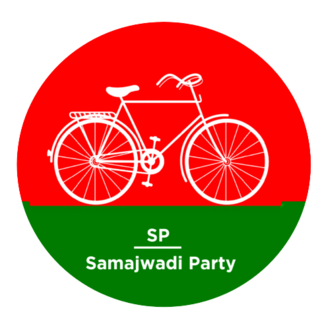
The Samajwadi Party is a socialist political party in India. It was founded by formerly Janata Dal politician Mulayam Singh Yadav and is headquartered in New Delhi. The Samajwadi Party is currently led by former Chief Minister of Uttar Pradesh, Akhilesh Yadav. He was chosen as the President for the first time in an Emergency meeting in 2017. He was chosen for second time in 2017 at Agra Convention of Samajwadi Party. He was chosen for the third time at the party's national convention held in September 2022 at Lucknow.
India has a parliamentary system as defined by its constitution, with power distributed between the union government and the states. India's democracy is the largest democracy in the world.

A Member of the Legislative Assembly (MLA) is a representative elected by the voters of an electoral district (constituency) to the legislature of State government in the Indian system of government. From each constituency, the people elect one representative who then becomes a member of the Legislative Assembly (MLA). Each state has between seven and nine MLAs for every Member of Parliament (MP) that it has in the Lok Sabha, the lower house of India's bicameral parliament. There are also members in three unicameral legislatures in Union Territories: the Delhi Legislative Assembly, Jammu and Kashmir Legislative Assembly and the Puducherry Legislative Assembly. Only a Member of the Legislative Assembly can work as a minister for more than 6 months. If a non-Member of the Legislative Assembly becomes a Chief Minister or a minister, he must become an MLA within 6 months to continue in the job. Only a Member of the Legislative Assembly can become the Speaker of the Legislature
Puducherry Lok Sabha constituency covers the entire Union Territory of Puducherry. Pondicherry became a union territory after the implementation of the Fourteenth Amendment of the Constitution of India in 1962 and changed its name to Puducherry in 2006. This constituency first held elections in 1967 and its first member of parliament (MP) was Thirumudi N. Sethuraman of the Indian National Congress.

Buldhana Lok Sabha constituency is one of the 48 Lok Sabha (parliamentary) constituencies of Maharashtra state in western India. This constituency largely represents Buldhana district in the Lok Sabha of Indian parliament, except Malkapur Assembly constituency, which is part of Raver Lok Sabha constituency from Jalgaon district of Khandesh region.

Bangalore North Lok Sabha constituency is one of the 28 Lok Sabha constituencies in the South Indian state of Karnataka. This constituency has been known by different names in its history. For the 1951 and every election since 1977 it has been known as Bangalore North. For the 1957 and 1962 elections it was known as Bangalore City. For the 1967 and 1971 elections it formed a constituency jointly with Bangalore South and was known as Bangalore. From 1951–73, this constituency resided in Mysore State. On 1 November 1973, Mysuru State was renamed as Karnataka.
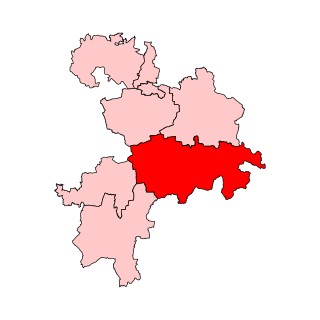
Dharapuram is a legislative assembly, that includes the city, Dharapuram. Its State Assembly Constituency number is 101. Dharapuram assembly constituency was part of Erode Lok Sabha constituency. It is one of the 234 State Legislative Assembly Constituencies in Tamil Nadu, in India.
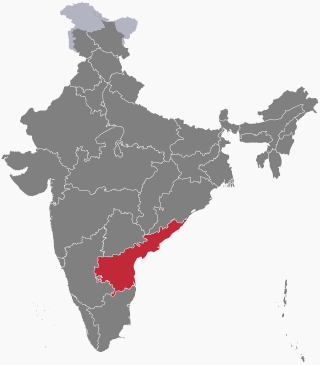
Elections in Andhra Pradesh state, India are conducted in accordance with the Constitution of India. The Assembly of Andhra Pradesh creates laws regarding the conduct of local body elections unilaterally while any changes by the state legislature to the conduct of state level elections need to be approved by the Parliament of India. In addition, the state legislature may be dismissed by the Parliament according to Article 356 of the Indian Constitution and President's rule may be imposed.
Jambhuwantrao Bapurao Dhote was an Indian politician. Known by his supporters as The Lion of Vidharbha & He is son-in-law of veteran Congress leader late Ramrao Adik.

Election to legislative assembly constituencies of Uttar Pradesh is held every five years and conducted by Election commission of India whereas the election to local bodies of Uttar pradesh is conducted by the Election Commission of Uttar pradesh. Parliamentary constituencies and Legislative assembly constituencies are also called "Lok sabha seats" and "Vidhan sabha seats" respectively. There are 80 parliamentary constituencies and 403 legislative assembly constituency in Uttar Pradesh. The state has seen 17 Vidhan Sabha elections and 16 Lok Sabha elections since independence.

Elections in Karnataka, a state in India are conducted in accordance with the Constitution of India. The Assembly of Karnataka creates laws regarding the conduct of local body elections unilaterally while any changes by the state legislature to the conduct of state level elections need to be approved by the Parliament of India. In addition, the state legislature may be dismissed by the Parliament according to Article 356 of the Indian Constitution and President's rule may be imposed.
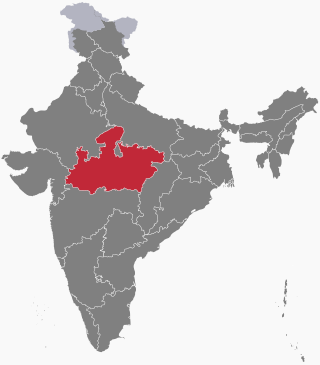
Elections in Madhya Pradesh, a state in India are conducted in accordance with the Constitution of India. The Assembly of Madhya Pradesh creates laws regarding the conduct of local body elections unilaterally while any changes by the state legislature to the conduct of state level elections need to be approved by the Parliament of India. In addition, the state legislature may be dismissed by the Parliament according to Article 356 of the Indian Constitution and President's rule may be imposed.
Alipore Assembly constituency was a Legislative Assembly constituency of South 24 Parganas district in the Indian state of West Bengal.

Elections in the state of Bihar, India are conducted in accordance with the Constitution of India. The Assembly of Bihar creates laws regarding the conduct of local body elections unilaterally while any changes by the state legislature to the conduct of state level elections need to be approved by the Parliament of India.
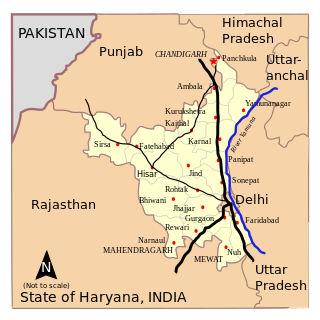
Elections in Haryana, which is a state in India, have been conducted since 1967 to elect the members of state-level Haryana Legislative Assembly and national-level Lok Sabha. There are 90 assembly constituencies and 10 Lok Sabha constituencies.
J. Mohammed Imam was an Indian politician and 2 time Member of Parliament (MP), represented the Chitradurga constituency in Lok Sabha, the lower house of the Indian Parliament.

A Member of Parliament in the Lok Sabha is the representative of a legislative constituency in the Lok Sabha; the lower house of the Parliament of India. Members of parliament of Lok Sabha are chosen by direct elections on the basis of the adult suffrage. The maximum permitted strength of members of parliament in the Lok Sabha is 550. This includes the maximum 530 members to represent the constituencies and states and up to 20 members to represent the union territories. Between 1952 and January 25,2020 two seats were reserved for members of the Anglo-Indian community. The current elected strength of the Lok Sabha is 543. The party—or coalition of parties—having a majority in the Lok Sabha chooses the Prime Minister of India.
Coorg was a constituency of the Lok Sabha. It was used in the parliamentary election of 1951–1952. The constituency elected a single member of the Lok Sabha and was the sole Lok Sabha seat for the Coorg State. As of 1952, the constituency had 94,593 eligible voters.
Birendra Chandra Dutta was an Indian communist politician. He founded the communist movement in Tripura. Dutta was a member of the 1st Lok Sabha, the 3rd Lok Sabha (1962–1967) and the 5th Lok Sabha (1971–1977).
























